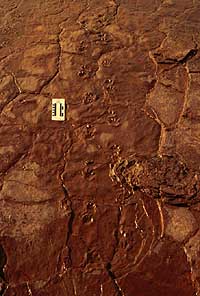    |
Brule TrackwaysThe Discovery One day in August, 1994, Howard van Allen and his brother Cory went for a walk along the shore of the Northumberland Strait near Brule, Nova Scotia. The two had often taken such walks, appreciating nature and keeping a sharp eye out for interesting rocks and fossils on the beach. This day, however, they made an astonishing discovery.
"As soon as I saw the first trackway," says Howard, "that was it. I was hooked!" Howard is now involved in the investigation of the site, led by Nova Scotia Museum Research Associate John Calder. To date, the site has yielded hundreds of footprints of known tetrapods as well as some species that have yet to be identified. But that is not the only thing that makes Brule an exceptionally important fossil site. It has also produced the world's first known example of a primitive Walchia forest in situ (ie. in it's original growth position). The upright trunks, impressions of fallen trees and abundant leaf imprints provide a valuable glimpse into an Early Permian environment. |
 Preserved in the rock at their feet were the
Preserved in the rock at their feet were the